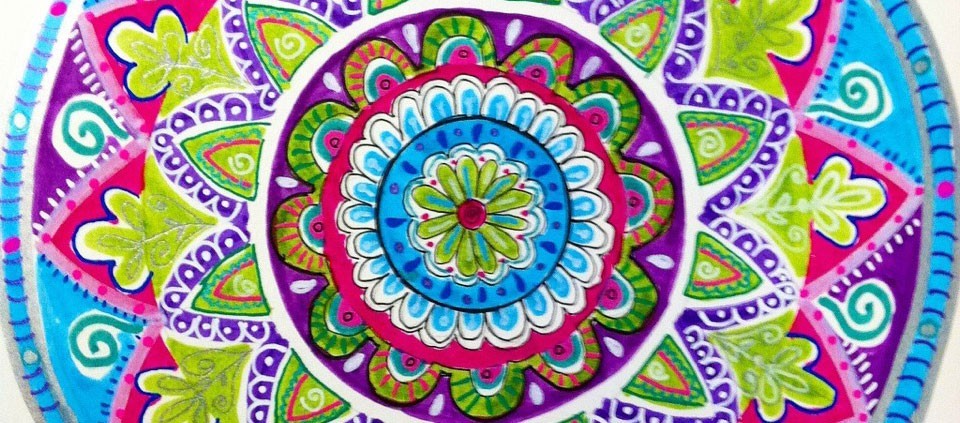The Mandala as a Practice for Visionary Creativity

Mandala art is sacred art in cultures around the world. Historically, it is an ancient way of using the circle as the basis for drawing or painting symbolic designs that revolve around centering, symmetry, and pattern. It has been used for healing, meditation, and shamanism all over the world.
There are so many ways to create mandalas. My approach with a group is to coach intuitive art-making with basic techniques and enticing materials that help beginners build toward their own expressions of beauty. The spiritual flow arises as we share conscious creativity, meditate together, practice yoga, and quiet the mind. I demonstrate sacred geometry, how to use pen and ink, how to doodle joyfully, and how to find the freedom to choose what suits the moment with collage or painting techniques. The playing field is wide open.
Sacred geometry is found most commonly when we observe geometric forms in nature. For example, the spiral in a Nautilus shell and the hexagonal cells of honey bees show us the microcosmic aspect of this geometry. Flowers and other plants display radial symmetry, by which they draw us to contemplate their innate beauty. Architecture also provides examples of the use of these mathematical principles, in the structures of sacred places such as the Pueblo kiva (the circle), cathedrals (the cross), temples, the circle within the square, and so on.
With this awareness, the artist’s sense of observation starts to flow naturally into the art-making process. We see the sacred geometry all around us and begin to understand how to express its beauty through our own eyes and hands. This is the path of the mandala, which connects us to our visionary inner world.
Yoga and metta meditation can calm the mental chatter of daily living in order to open the creative channel and let our imagination emerge. What we make is not as important as the process of making, which links our minds, hearts, and hands in joyful activity. Each mandala is as unique as the person creating it.
When working with a group, I like to encourage community and the nourishment that comes from open studio time. Art, like yoga, is experiential. Often, my students feel transformational energy that opens new portals to their inner world. In daily life, we often crave creative time, while finding it challenging to carve out the space for it. Yet art-making can be a practice, a daily ritual that enhances mind, body and spirit—just as a yoga practice does.
My favorite teaching mantras are “Art is not separate” and “Practice takes practice.” I see the mandala as a holistic art form that connects us to each other, to our own creative life force, and to the world around us—so we can live the creative life we have dreamed of manifesting.
Find out about upcoming programs with Karen Arp-Sandel at Kripalu.
© Kripalu Center for Yoga & Health. All rights reserved. To request permission to reprint, please email editor@kripalu.org.
Karen Arp-Sandel, BA, KYT, KYIS, is an artist and designer who brings colorful creativity to her work as an educator, humanitarian, and spiritual activist.
Full Bio and Programs